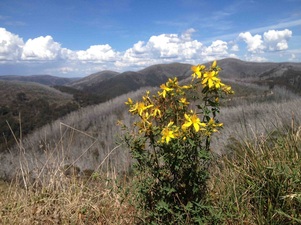| Smith Ecology Lab |
|
⚠️ This page hasn't been updated in a while. For info on current projects, please see the People page. ⚠️

Fire ecology and management
Well studied changes in plant demography after fire have led to conceptual, statistical and simulation-based models to predict the effects of different fire regimes on vegetation. Progress in this direction for animals has been slower than for plants, partly because of the difficulty in obtaining animal life history data. At the community level, a functional trait-based approach for predicting fire responses (like those used for plants) holds promise for use in animal studies. However, this approach requires detailed information on life history traits, including survival, reproduction and dispersal which is not available for most animal species in fire-prone ecosystems. Understanding demographic changes of animal populations after fire is critical if we are to develop a predictive framework for ecological fire management.
Well studied changes in plant demography after fire have led to conceptual, statistical and simulation-based models to predict the effects of different fire regimes on vegetation. Progress in this direction for animals has been slower than for plants, partly because of the difficulty in obtaining animal life history data. At the community level, a functional trait-based approach for predicting fire responses (like those used for plants) holds promise for use in animal studies. However, this approach requires detailed information on life history traits, including survival, reproduction and dispersal which is not available for most animal species in fire-prone ecosystems. Understanding demographic changes of animal populations after fire is critical if we are to develop a predictive framework for ecological fire management.

Predicting plant responses to changing fire regimes
The role of fire in historical plant evolution is well understood but there is little knowledge of how species will adapt to the unprecedented changes in fire regimes which are occurring globally.
There is ample evidence that invasive plant species can rapidly adapt to new environments but no studies have yet examined rapid evolution of fire-adaptive traits (e.g. fire-stimulated germination) in invasive species. This is surprising considering that invasive species can alter fire regimes when they change fuel properties and when fire promotes their establishment and growth. The result is a positive ecological feedback, whereby the invasion process accelerates and fire frequency and/or intensity increases, sometimes beyond the level where native vegetation can recover. But do adaptive changes contribute to these feedbacks?
We are investigating if adaptation in invasive species can reinforce changes in fire regimes by increasing the persistence of fire-tolerant or fire-promoting lineages.
The role of fire in historical plant evolution is well understood but there is little knowledge of how species will adapt to the unprecedented changes in fire regimes which are occurring globally.
There is ample evidence that invasive plant species can rapidly adapt to new environments but no studies have yet examined rapid evolution of fire-adaptive traits (e.g. fire-stimulated germination) in invasive species. This is surprising considering that invasive species can alter fire regimes when they change fuel properties and when fire promotes their establishment and growth. The result is a positive ecological feedback, whereby the invasion process accelerates and fire frequency and/or intensity increases, sometimes beyond the level where native vegetation can recover. But do adaptive changes contribute to these feedbacks?
We are investigating if adaptation in invasive species can reinforce changes in fire regimes by increasing the persistence of fire-tolerant or fire-promoting lineages.

Science-based grassland restoration
With continuing urban expansion, biodiversity conservation and human asset protection often require different regimes for managing wildfire risk. I have a long-term collaboration with Dr Richard Milner (Australian Captial Territory Parks and Conservation) to develop new ways of restoring habitat for threatened species while reducing fire fuel load in a rapidly developing urban area around Canberra, Australia.
Read about the pilot phase of this project and see our published scientific work on using rocks in restoration and mowing to conserve biodiversity. Also check out our 3-minute video explaining some of this work.
With continuing urban expansion, biodiversity conservation and human asset protection often require different regimes for managing wildfire risk. I have a long-term collaboration with Dr Richard Milner (Australian Captial Territory Parks and Conservation) to develop new ways of restoring habitat for threatened species while reducing fire fuel load in a rapidly developing urban area around Canberra, Australia.
Read about the pilot phase of this project and see our published scientific work on using rocks in restoration and mowing to conserve biodiversity. Also check out our 3-minute video explaining some of this work.
Site powered by Weebly. Managed by HostGator